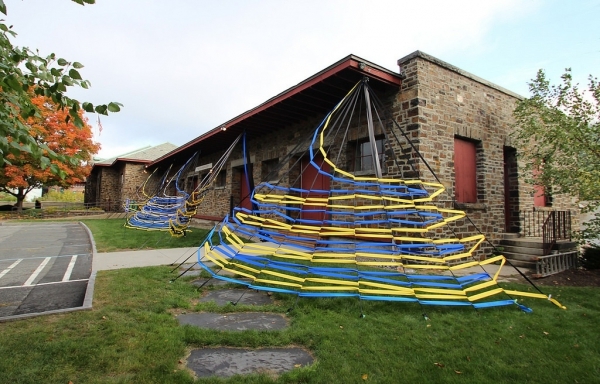BRATTLEBORO — Four new exhibits are now on display at the Brattleboro Museum & Art Center (BMAC). Two of the new exhibits extend the museum's spring 2015 investigation into fiber art, while the other two showcase the creative pursuits of two southern Vermont artists.
Filling the museum's Wolf Kahn & Emily Mason Gallery is the “Hand Towel Project,” an installation by artists Elizabeth Billings and Andrea Wasserman that explores both the precarious condition of our planet and the profound difference art can make in people's lives.
The installation consists of hundreds of handmade hand towels suspended from branches hanging from the ceiling of the gallery, creating a canopy that arches over viewers' heads. The towels are embroidered or printed with images of trees and fragments of poems. Other images and text are projected onto the hand towels, immersing viewers in a shifting environment of light and shadow.
“In the throw-away, consumer-driven society we live in,” said Billings and Wasserman, “we want to build a small intentional-yet-random community focused on the sustainable practices of caring about what we use and how we use it.” When the exhibit ends, the hand towels will be given away, creating a community brought together through hand towels, shared words, and sustainable practices.
Billings and Wasserman will give a talk at BMAC on Thursday, May 14 at 7 p.m.
Outside the museum, Alisa Dworsky's “Motion-Line-Form” also employs weaving as the basis of a site-specific art installation. In this case, the act of creating five maypole-inspired structures is carried out by dancers Candice Salyers and Dahlia Nayar, whose choreography includes weaving colored ribbons within a structure affixed to the museum's southwestern facade.
Of her 70-foot-long installation, Dworsky has written, “I hope to transform a prosaic space into a charged one that can dislodge us from the unfocused gaze we so often direct at the everyday world. Made of polyester ribbon, the piece will be constructed in a performance as a radical transformation of the maypole dance. Together the dancers function like a loom."
Several of Dworsky's drawings will also be on view in the museum's Spotlight Gallery.
In 2002, photographer Evie Lovett of Westminster West, began taking photographs of drag queens getting dressed backstage for the monthly drag show at the Rainbow Cattle Company, a now-defunct gay bar in Dummerston.
In the 13 years since, Lovett's enthralling photographs, which depict a remarkable process of personal transformation, have been exhibited widely, including most recently on a three-year tour of all 14 Vermont counties. That tour, which was organized by the Vermont Folklife Center, comes to a close at BMAC, a fitting destination for a journey that began just a few miles away in Dummerston.
The exhibit consists of approximately 35 black-and-white photographs, supplemented by audio interviews with many of the drag queens, who refer to themselves as the “Ladies of the Rainbow.” Also on view are visitor comments the exhibit elicited as it toured Vermont.
Lovett will give a talk at BMAC on Wednesday, May 20, at 7 p.m., and the Ladies of the Rainbow will put on a drag show at the museum on Saturday, June 13, at 8 p.m.
Artist Gregory Miguel Gómez divides his time between Boston and Putney. He works in a variety of media and has executed numerous large-scale public art projects, including one at the Vermont Fire Academy in Pittsford. For Gómez's exhibit at BMAC, the museum's chief curator, Mara Williams, has chosen to showcase both his sculpture and his drawings.
As visitors approach the museum's front entrance, they will encounter Gómez's “Reclining Infinity,” a 15-foot-long snaking sculpture composed of bronze discs supported by an armature of welded stainless steel rods.
A second Gómez sculpture, “Open Loop,” will occupy the center of the museum's East Gallery, the walls of which will contain charcoal and sandblasted gouache drawings from Gómez's “Flawed Nets & Circuits” series.
“My designs reference mathematics, symbology, and other iconography,” Gómez said. “They serve as metaphorical statements, and viewers are free to project their own interpretations and meaning."
Two other exhibits remain on view through June 21.
Alongside these four exhibits are two exhibits that opened in March: “Donald Saaf: Contemporary Folk Tales” and “Children of the Oasis.” All six exhibits will remain on view through Sunday, June 21.
